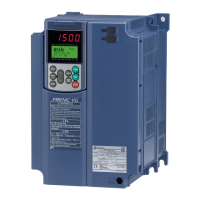5-33
(Point A)
To set the reference frequency to 0 Hz for an analog input being at 1 V, set the bias to 0% (F18
= 0). Since 1 V is the bias base point and it is equal to 10% of 10 V (full scale), set the bias
base point to 10% (C50 = 10).
(Point B)
To make the maximum frequency equal to the reference frequency for an analog input being
at 5 V, set the gain to 100% (C32 = 100). Since 5 V is the gain base point and it is equal to 50%
of 10 V (full scale), set the gain base point to 50% (C34 = 50).
The setting procedure for specifying a gain or bias alone without changing any
base points is the same as that of Fuji conventional inverters o
FRENIC5000G11S/P11S series, FVR-E11S series, etc.
F20 to F22
H95
DC Braking 1 (Braking starting frequency, Braking level, and Braking time)
DC Braking (Braking response mode)
F20 through F22 specify the DC braking that prevents motor 1 from running by inertia during
decelerate-to-stop operation.
If the motor enters a decelerate-to-stop operation by turning OFF the run command or by
decreasing the reference frequency below the stop frequency, the inverter activates the DC
braking by flowing a current at the braking level (F21) during the braking time (F22) when the
output frequency reaches the DC braking starting frequency (F20).
Setting the braking time to "0.0" (F22 = 0) disables the DC braking.
Braking starting frequency (F20)㩷
F20 specifies the frequency at which the DC braking starts its operation during motor
decelerate-to-stop state.
Braking level (F21)㩷
F21 specifies the output current level to be applied when the DC braking is activated. The
function code data should be set, assuming the rated output current of the inverter as 100%,
in increments of 1%.
Braking time (F22)㩷
F22 specifies the braking period that activates DC braking.
Braking response mode (H95)㩷
H95 specifies the DC braking response mode.
Data for H95 Characteristics Note
0 Slow response. Slows the rising edge of
the current, thereby preventing reverse
rotation at the start of DC braking.
Insufficient braking torque may
result at the start of DC braking.
1 Quick response. Quickens the rising
edge of the current, thereby accelerating
the build-up of the braking torque.
Reverse rotation may result
depending on the moment of
inertia of the mechanical load and
the coupling mechanism.
It is also possible to use an external digital input signal as an "Enable DC braking"
terminal command DCBRK.
As long as the DCBRK command is ON, the inverter performs DC braking,
regardless of the braking time specified by F22.
Turning the DCBRK command ON even when the inverter is in a stopped state
activates DC braking. This feature allows the motor to be excited before starting,
resulting in smoother acceleration (quicker build-up of acceleration torque).

